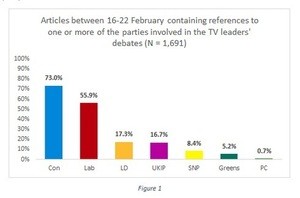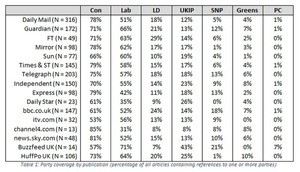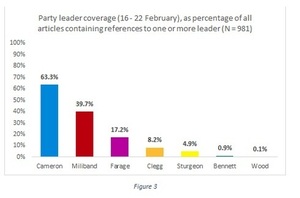A seven-horse race? How minor parties are being squeezed out of campaign coverage
Posted by: Dr Stephen Cushion and Dr Gordon Neil Ramsey
When broadcasters revised the format of the TV leaders’ debates to include not four but seven political parties, it was a reaction to the UK’s fast changing political landscape.
The original line-up included the three established major parties – Conservative, Labour and Liberal Democrat – as well as UKIP after being elevated to “major party” status by broadcast regulators during the EU election campaign. But Prime Minister David Cameron was quick to challenge this composition, arguing that if UKIP should be included so should other minor parties, such as the Greens.
Worried about the prospect of “empty chairing” the Prime Minster and being open to possible legal challenge, broadcasters soon responded by not only including the Greens, but the SNP and Plaid Cymru.
The decision gave credence to predictions that the 2015 general election would see the end of the UK’s longstanding two-party system and witness a rise in the fortunes of the so-called minor parties. Since a hung parliament is predicted to be the most likely outcome, including the possible leaders of potential coalition-building parties in the high profile TV debates seems a sensible way of allowing voters to better understand the choices they face on election day.
Two party squeeze
However, new research from the Media Standards Trust suggests that, far from the media reflecting the full range of political views competing to gain power at Westminster, eleven weeks prior to the general election the minor parties are being squeezed out of coverage. As Figure 1 illustrates, campaign coverage between 16-22 February in the most popular online news providers in the UK – from the BBC, to the Guardian, Daily Mail and Buzzfeed (see here for full sample and method) – overwhelmingly focused on the Conservative and Labour party.
In the 1,691 articles featuring parties that will appear on the TV leaders’ debates, the Conservatives appeared in almost three-quarters of coverage (73%) whereas Labour appeared in well over half (55.9%). Despite the party’s incumbency bonus, the Liberal Democrat’s shared equal prominence with UKIP (approx. 17%). The Greens, by contrast, featured in just 5% of articles examined – less the SNP (8.4%) but substantially more than Plaid Cymru (less than 1%).
As Table 1 demonstrates, this imbalance was replicated across all news sources included in the analysis. With only a couple of exceptions (Buzzfeed and the Daily Star, both of which published a small amount of articles referencing political parties), the parties split into three tiers based on the volume of articles in which they featured. Labour and the Conservatives typically featured in between one-half and three-quarters of articles in which any party was mentioned. The Liberal Democrats and UKIP appeared much less often – usually between 10% and 20% of articles. The remaining minor parties – SNP, Greens and Plaid Cymru – featured considerably less often, and in some news outlets not at all.
It is, of course, difficult to reach any clear conclusions about election coverage based on a week’s analysis. But the Media Standards Trust’s cumulative analysis of coverage over seven weeks reinforces the Conservative and, to a lesser extent, Labour dominance of campaign reporting (see Figure 2).
For the seven week period between January 5 and February 22, the balance of coverage between the seven parties was broadly similar to the seven-day period shown in Figure 1. Once again, the Conservatives dominated, appearing in over three-quarters of articles (75.8%) featuring any party, while references to the Labour Party made up over half of coverage (55%). The Lib Dems featured in just over one-fifth of news (21.6%), and the UKIP figures show that Week 7 was a good one for them – on average, they appeared in just 14.6% of articles in Weeks 1-7.
While the aggregate figures for the three minor parties – theSNP, Greens and Plaid Cymru – were slightly better than in Week 7, they still appeared far less than the two major parties.
Cameron the most visible leader
Since political parties today are increasingly defined by their leaders – exacerbated by the significance paid to the TV debates – their prominence in coverage can reveal an agenda setting power. When isolating the reporting of the seven leaders taking part in the TV debates between 16-22 February (Figure 3), David Cameron alone appeared in almost two-thirds (63.3%) of articles in which any leader was featured, whereas Ed Miliband appeared in roughly a third less than the Prime Minster (39.7%)
Beyond the two major parties, Nigel Farage (17.2%) appeared to a far greater extent than Nick Clegg (8.2%), reinforcing the widespread perception that UKIP’s electoral success lies in its media savvy leader. While Nicola Sturgeon’s media prominence (4.9%) was not far behind Clegg, the Green Party’s Natalie Bennett and Plaid Cymru’s Leanne Wood just managed to scrape 1% between them.
Needless to say, over the next ten weeks or so parties – and their leaders – will enjoy highs and lows in media coverage. Natalie Bennett’s car crash interview on LBC radio last week (shortly after the period analysed by the Media Standards Trust), for example, temporarily pushed the Greens up the campaign agenda. But the episode was short lived as debates about cash for access between Labour and Conservative took centre stage. Moreover, while many candidates will face awkward moments and campaign set- backs, it is arguably the daily drip of news about parties’ policy positions and their credibility in election reporting that will most influence the electoral outcome.
In this respect, according to both the Media Standards Trust’s snapshot weekly picture of coverage as well as the cumulative seven week analysis, the opportunities for the minor parties to pitch their polices and layout their vision for the future appear limited. While the latecomers to the TV debates – the SNP, Plaid and Greens – can use this platform to even up the contest, in day-to-day coverage they are currently being squeezed out of the campaign on the most popular UK online news sites.
Far from the 2015 general campaign turning into a seven-horse race, the longstanding two-party dominance of Conservative and Labour remains firmly intact.
Stephen Cushion is a Senior Lecturer at the School of Journalism, Media and Cultural Studies, Cardiff University
Gordon Neil Ramsay is a Research Fellow at the Media Standards Trust and a Visiting Research Fellow at the Policy Institute at King’s College London
This post originally appeared on TotalPolitics.com




